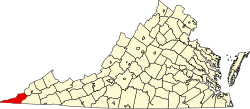Mayflower, Virginia | |
|---|---|
Unincorporated community | |
| Coordinates: 36°49′47″N83°4′51″W / 36.82972°N 83.08083°W | |
| Country | United States |
| State | Virginia |
| County | Lee |
| Elevation | 1,811 ft (552 m) |
| Time zone | UTC-5 (Eastern (EST)) |
| • Summer (DST) | UTC-4 (EDT) |
| GNIS feature ID | 1497011 [1] |
Mayflower is an unincorporated community in Lee County, Virginia, United States.


